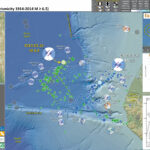Well well. The faults in southern CA are large in number. Following Danielle’s lead, I looked into the tectonics of the region. The Shaw et al. (2002) paper has a really good summary of the tectonics of this region of…
M 5.1 earthquake in La Habra
All Right! A good sized shaker (nice and small) just happened near La Habra in southern CA. Here is the USGS web site for this earthquake. Here is some general information about earthquakes in southern CA. This is a really…
Oso, WA landslide 2014/03/22 Historical Animations
Here are a few animations I made based on historical aerial imagery. There are four animations that run the years 1989, 2003, 2005, 2006, 2007, 2009, 2011, and 2013. I used the historic imagery available from google earth. There could…
Interseismic Fault Coupling: the 2014 March Northern Chile Swarm
Given the paucity of great earthquakes in the region of the recent earthquake swarm along the subduction zone offshore or northern Chile, we are curious to know if there will be a large magnitude earthquake there. The seismologic record of…
Still kicking off some aftershocks in northern Chile
Here is the latest view of the seismicity associated with this earthquake swarm offshore northern Chile. I first mentioned this since I thought it was an interesting region to get some earthquakes. Read more about that on that first page.…
Indian Ocean M 5.4 2014/03/27
Good Morning! A very coolio M 5.4 earthquake in the northern Indian Ocean between the Ninetyeast Ridge and Sri Lanka. Here is the USGS webpage for this earthquake. This is interesting because it is northwest of a swarm of earthquakes…
Andaman Sea Swarm M 6.5
Here is a good sized earthquake swarm in the Andaman Sea. I am a little late posting this, I was otherwise detained. Here is the USGS webpage for the Mw 6.5 earthquake. The Andaman Sea is a region of back-arc…
Gorda plate earthquake animations
I have put together a couple animations of the earthquake epicenters preceding, during, and following the recent earthquake swarm in the Gorda plate. Here is the first page I put together for this M 6.8 earthquake. Here are some maps…
M 6.7 earthquake swarm in northern Chile! 2014/03/06
There was a really cool earthquake swarm in northern Chile. This swarm of earthquakes are at depths that places them near the subduction zone fault interface. This earthquake swarm is interesting for several reasons, the first of which is that…
M 5.2 Gorda plate earthquake 2014/03/13
This is a very cool earthquake! In the last few days, there was an earthquake swarm in the southeastern Gorda plate. This earthquake released accumulated strain along the faults in that region. A result of these earthquakes is that the…

